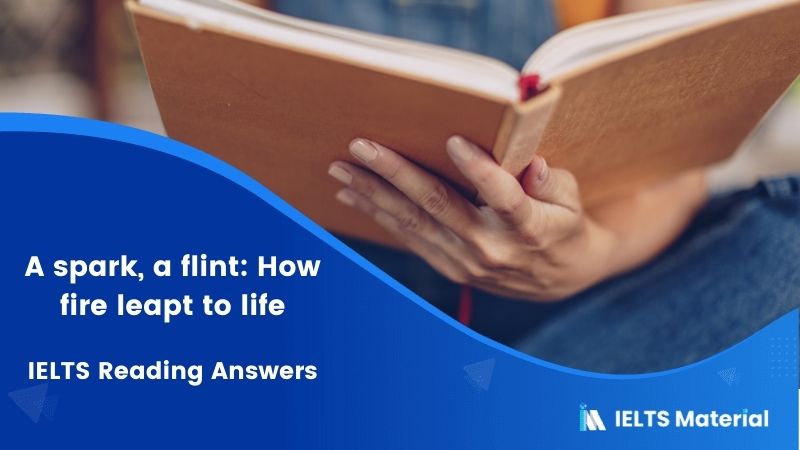A spark, a flint: How fire leapt to life – IELTS Reading Answers
8 min read
Updated On
-
Copy link
Table of Contents

Limited-Time Offer : Access a FREE 10-Day IELTS Study Plan!
The Reading Module of the IELTS can be the top-scoring category, with diligent practice. To achieve the best results in this section, you must understand how to approach and answer the different Question types in the Reading Module. By solving and reviewing Sample Reading Questions from past IELTS papers, you can ensure that your Reading skills are up to the mark.
The Academic passage ‘A spark, a flint: How fire leapt to life’ is a reading passage that appeared in an IELTS Test.
Since questions get repeated in the IELTS exam, these passages for ideal for practice. If you want more practice, try taking an IELTS reading practice test.
The question types found in this passage are:
Summary Completion
In the summary completion type of question, you will be provided with a summary of information from a text, and there will be a few gaps. You will either get a list of words to be filled in the gaps or you could be asked to find answers from the reading passage. You will have to insert a few words from the text into the gaps. All of the information in the summary will also be available in the reading text. However, they will be using paraphrasing and synonyms. Thus, you cannot expect to find the exact words.
Matching Information Questions
In matching the information type of question, a list which contains information is taken from the paragraphs. You are asked to find out the paragraph from which the information is taken. Sometimes the question may be tricky because the information given might not be in exact words as given in the paragraph. Instead, it will be paraphrased so you need to read the paragraph to understand the meaning/idea behind it to answer these questions.
A spark, a flint: How fire leapt to life






Answers
1 Answer: preserve
Question Type: Summary Completion
Answer location: Paragraph 1, line 2
Answer explanation: The answer is clearly mentioned in the said paragraph and line. In the passage, it is said that “unable to make flame for themselves, the earliest peoples probably stored fire by keeping slow burning logs alight or by carrying charcoal in pots.” Since an early age fire is considered a heavenly gift, however, earlier people weren’t aware of ways to produce fire and that is the reason they tried to store (preserve) it.
2 Answer: unaware
Question Type: Summary Completion
Answer location: Paragraph 1, line 2
Answer explanation: Paragraph 1 provides the information that “unable to make flame for themselves, the earliest peoples probably stored fire by keeping slow burning logs alight or by carrying charcoal in pots.” People of early age tried preserving the fire because they were unable/unaware of ways to create it for themselves.
3 Answer: chance
Question Type: Summary Completion
Answer location: Paragraph 2, line 2
Answer explanation: In the reference paragraph, it is said that “it was probably a secondary invention, accidentally made during tool-making operations with wood or stone.” Here, it is mentioned that the invention of flames was made accidentally. The term accidentally can be paraphrased as by chance.
4 Answer: friction
Question Type: Summary Completion
Answer location: Paragraph 2, line 3
Answer explanation: In the reference paragraph, the author mentions that “studies of primitive societies suggest that the earliest method of making fire was through friction.” Here, the term earliest method of making fire can be understood as the first fire-lighting method. Thus, the first fire-lighting method was through friction.
Unlock Answer
Signup/Login and get access to the answers
5 Answer: rotating
Question Type: Summary Completion
Answer location: Paragraph 2, last line
Answer explanation: Few lines in the said paragraph discuss that “European peasants would insert a wooden drill in a round hole and rotate it briskly between their palms. This process could be speeded up by wrapping a cord around the drill and pulling on each end.” One of the early methods of creating fire was through friction, such as in Europe people would drill a hole in a wooden log and rapidly rotate a wooden stick in it.
6 Answer: percussion
Question Type: Summary Completion
Answer location: Paragraph 4, line 1
Answer explanation: In the said paragraph, you can find out that “Percussion methods of fire-lighting date back to Paleolithic times, when some Stone Age tool-makers discovered that chipping flints produced sparks.” The persistent chipping to produce a spark is also known as the percussion method, which is widespread in Europe and other countries.
7 Answer: Eskimos
Question Type: Summary Completion
Answer location: Paragraph 4, line 2
Answer explanation: The answer is clearly mentioned in the said paragraph and line. You must note the paraphrasing here. In the passage, it is said that “the technique became more efficient after the discovery of iron, about 5000 years ago In Arctic North America, the Eskimos produced a slow-burning spark by striking quartz against iron pyrites, a compound that contains sulphur.” The term Eskimos is used to refer to two closely related Indigenous peoples. Thus, the technique of percussion became famous/widespread in other peoples such as the Chinese and Eskimos.
8 Answer: despite
Question Type: Summary Completion
Answer location: Paragraph 5, line 1
Answer explanation: The opening line of paragraph 5 puts forward the idea that “Fire-lighting was revolutionised by the discovery of phosphorus, isolated in 1669 by a German alchemist trying to transmute silver into gold.” Despite the fact that phosphorus was introduced in 1669, Europeans still continued using the same old method of creating fire till the 1850s.
9 Answer: F
Question Type: Matching Information
Answer location: Paragraph 9, last line
Answer explanation: If you read thoroughly, there’s a line that claims, “Lundstrom’s safety matches were safe because the red phosphorus was non-toxic; it was painted on to the striking surface instead of the match tip, which contained potassium chlorate with a relatively high ignition temperature of 182 degrees centigrade.” Lundstrom created safety matches and it was made using a non-toxic (less poisonous) type of phosphorus.
10 Answer: D
Question Type: Matching Information
Answer location: Paragraph 8, line 1
Answer explanation: The opening line of paragraph 8 claims that “Walker never patented his invention, and three years later it was copied by a Samuel Jones, who marketed his product as Lucifers.” The product which Walker created/invented was copied and an identical product was launched by Samuel Jones named lucifers.
11 Answer: E
Question Type: Matching Information
Answer location: Paragraph 8, line 3
Answer explanation: In the said paragraph, refer that, “however, since white phosphorus is a deadly poison, from 1845 match-makers exposed to its fumes succumbed to necrosis, a disease that eats away jaw-bones.” Charles Sauria a French chemistry student produced the first strike-anywhere match which caused a deadly illness (a disease that eats away jaw-bones).
12 Answer: C
Question Type: Matching Information
Answer location: Paragraph 7, line 1
Answer explanation: Paragraph 7 puts forward the information that “the first matches resembling those used today were made in 1827 by John Walker, an English pharmacist who borrowed the formula from a military rocket-maker called Congreve.” According to this passage, the first to look like (resemble) modern ( used today) matches is called Congreve.
13 Answer: G
Question Type: Matching Information
Answer location: Paragraph 11, line 3
Answer explanation: The answer is clearly mentioned in the said paragraph and line. In the passage, it is said that “the innovation didn’t catch on until after 1896, when a brewery had the novel idea of advertising its product in match books.” A brewery in 1896, came up with the idea of advertising the products in match books for the first time.
14 Answer: A
Question Type: Matching Information
Answer location: Paragraph 6, line 1
Answer explanation: In the reference paragraph, the author mentions that “the quest for a practical match really began after 1781 when a group of French chemists came up with the Phosphoric Candle or Ethereal Match, a sealed glass tube containing a twist of paper tipped with phosphorus.” In 1781, a group of French chemists came up the idea of an airtight/sealed glass container with a twist of paper tip and phosphorus, known as the Phosphoric Candle or Ethereal Match.
15 Answer: C
Question Type: Matching Information
Answer location: Paragraph 7, line 1
Answer explanation: In the said paragraph, you can find out that “the first matches resembling those used today were made in 1827 by John Walker, an English pharmacist who borrowed the formula from a military rocket-maker called Congreve.” John Walker in 1827 created/made match design with the idea borrowed from a military (army design) rocket-maker called Congreve
Check More IELTS Reading Answers
Also check :
Practice IELTS Reading based on question types

Start Preparing for IELTS: Get Your 10-Day Study Plan Today!
Recent Articles

Nehasri Ravishenbagam

Haniya Yashfeen

Haniya Yashfeen

Haniya Yashfeen




Post your Comments